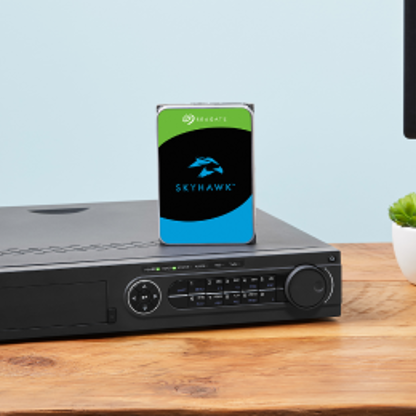
When businesses plan a new video surveillance system, they often focus on the number of cameras, video resolution, and camera types they need. However, one crucial component is frequently overlooked: video storage. Without the right storage solution, even the most advanced surveillance setup can fall short of its security goals.
Network Video Recorder (NVR) storage is essential for managing the vast amounts of video data generated by modern surveillance systems. As businesses upgrade from 1080p to 4K cameras and integrate AI-driven analytics, storage demands can increase exponentially—sometimes by as much as 280%. Without sufficient storage capacity, organizations risk losing critical footage, facing compliance challenges, and dealing with performance bottlenecks.
To keep pace with these growing requirements, businesses must treat video storage as a core component of their security infrastructure. This guide explores the role of NVR storage, different storage options, key factors affecting capacity, and best practices to ensure optimal performance and longevity
What is NVR storage?

NVR storage is a system used to store video footage captured by Internet Protocol (IP) cameras. NVRs receive live video feeds over a network and record them directly into a storage device, such as a dedicated NVR hard drive, for easy management and retrieval of that content.
The setup offered by NVR storage also allows the remote access and management of video data, resulting in better security monitoring and seamless integration with other security systems and services.
Why is NVR important in IP security camera systems?
As businesses upgrade from analog surveillance to high-definition IP cameras, they require modern video storage solutions that can handle increasing workload demands, offer scalability, and enable seamless remote access.
NVR storage is designed to meet these evolving needs. With high workload ratings and ample capacity for HD and 4K video, NVR systems provide a scalable solution that allows businesses to expand storage and add cameras as needed.
Additionally, NVR storage improves remote access and seamlessly integrates with AI-driven surveillance technologies, allowing for advanced features like object detection, facial recognition, and real-time analytics—capabilities that traditional analog systems simply can’t match.
Types of NVR storage for IP security camera systems.

When selecting the ideal NVR storage solution for your business, there are several options to consider: on-premises, cloud-based, and hybrid environments. Each offers distinct advantages depending on your specific needs, security requirements, and scalability goals.
- On-prem systems are installed directly at your business location, giving you full control of your data and infrastructure. While on-prem storage can offer faster data retrieval and increased security, it also requires more investment in hardware, maintenance, and physical space.
- Cloud-based systems store your surveillance data remotely, off-site, making it accessible from virtually anywhere. This option provides flexibility, scalability, and reduces the need for on-site infrastructure. However, it can be subject to latency and bandwidth issues, and ongoing subscription costs can accumulate over time.
- Hybrid NVR storage combines the benefits of on-premises and cloud-based systems, giving businesses the flexibility to store critical footage locally while leveraging the cloud for backup and remote access. This balanced approach offers redundancy, scalability, and reliability without compromising performance.
Pros and cons of NVR storage options.
| Storage type |
Pros |
Cons |
| On-premise |
Full control, no bandwidth reliance, fast local access |
Higher upfront cost, maintenance required, space limitations |
| Cloud |
Remote access, scalable, minimal on-site hardware |
Dependent on internet, potential latency, ongoing costs |
| Hybrid |
Best of both worlds, flexible, redundancy, scalable |
More complex setup, may require additional management |
Choosing the right hard drive for NVR storage.
When selecting hard drives for your NVR storage system, Seagate SkyHawk™ video drives stand out as an excellent choice. Designed specifically for video systems, SkyHawk drives offer high-capacity storage, optimized firmware, and a reliability rating capable of supporting workloads of hundreds of terabytes per year.
SkyHawk drives are engineered for 24×7 operation, designed to handle up to 64 HD cameras and up to 32 AI streams. With SkyHawk Health Management, these drives monitor their own health, confirming you receive proactive alerts in order to prevent potential failures before they happen. Whether you’re deploying DVR or NVR systems, SkyHawk drives are built to support high-performance, high-capacity environments while maintaining long-term reliability.
Factors affecting NVR storage capacity.

Your video surveillance system’s storage capacity requirements are affected by several factors ranging from the type of cameras used, the quality of video you’re storing, and any retention requirements dictating how long your video must be stored in your system.
When planning your NVR system, you’ll need to allocate enough storage based on the following criteria:
- Camera resolution and frame rate. Higher resolutions and higher frame rates improve the quality of your video data, but they also increase your capacity requirements.
- Video compression formats. Newer cameras offering higher resolution footage may also offer compression formats that reduce the storage requirements for this data. H.265 compression, for example, is up to 50% more efficient than H.264 compression.
- Number of cameras. While the type of camera and compression format can influence your storage needs, a higher number of cameras tends to correlate to increased storage capacity requirements.
- Retention period requirements. Whether you’re facing industry-specific retention requirements or have internal company retention policies to follow, a longer video retention period translates to greater storage capacity needs.
Our video storage calculator can help you determine your storage needs based on the above factors.
Maximizing NVR storage efficiency: Practical tips.
Want to make the most of your NVR storage efficiency? Consider these strategies:
- Consider the value of HD vs. non-HD video. While HD video can be very valuable in identifying faces, stolen goods, license plates, and other critical details, not every business will find it valuable to invest in HD video recording. Cameras intended to track activity or movement in an area, for example, may not require the precision and clarity offered by HD video.
- Use motion-triggered recording. This simple strategy can greatly reduce the volume of your video data, decreasing your storage requirements.
- Configure your camera’s positioning and settings. Adjusting camera angles, choosing compression formats, and managing other settings can minimize unnecessary recording and waste in your surveillance system.
- Manage your data bandwidth. When recording to a cloud-based location, your camera settings may need to be calibrated to optimize your bandwidth usage.
Best practices for NVR storage deployment and management.
Here are six best practices systems integrators can implement to get the most out of their SkyHawk drive and NVR storage.
- Safe handling. Prior to installation, when removing your SkyHawk drive from shipping materials, keep it in its protective packaging until it is safely mounted in the NVR. Any mishandling, such as stacking, dropping, or shaking the drive, can result in a crash where the head assembly hits the platter, resulting in a physical scratch that affects access to data.
- Temperature. A cool, consistent air supply is needed to flow over and between hot components to extract the heat. To achieve this, use high-speed fans to cool the air and remove hot air without obstruction.
- Dust elimination. In dusty or dirty environments, protect SkyHawk drives by installing dust filters or air intake ports.
- Acclimation. When transporting drives from cold to warm settings—such as from a van to an air-conditioned room—slowly acclimate the drives to avoid condensation inside the drive.
- Vibration. Multi-bay surveillance systems often subject hard drives to high fan vibration, chassis-based stimulus, and drive-to-drive excitation. Integrators can mitigate this problem by simply using a SkyHawk drive, which is equipped with rotational vibration sensors featuring AcuTrac® technology to support functionality and minimal performance degradation.
- Remote health monitoring software. Use monitoring software such as SkyHawk Health Management to assess drive health and get alerts to potential issues before they happen. The result is proactive troubleshooting that makes prevention, intervention, and recovery possible. Deploying a drive with remote health monitoring software also allows integrators to provide a value-added service for maintenance contracts that can drive recurring monthly revenue.
By implementing these tactics and deploying SkyHawk drives, systems integrators will improve their customer’s storage capabilities while simultaneously reducing maintenance and service calls. The end result is a win-win situation where there’s increased customer satisfaction and loyalty as well as increased profit margins for integrators.
Common mistakes to avoid when setting up NVR storage.
NVR storage provides the infrastructure needed to support modern video systems, but it isn’t foolproof. To make sure your system is set up for success, you’ll need to avoid the following missteps:
- Underestimating your storage needs. If storage space runs out, you’ll suffer from data loss and/or system failures.
- Failing to consider future scalability. Without adequate room to grow, you won’t be able to add new cameras or upgrade your video resolution over time.
- Relying on consumer-grade hard drives. The demanding workloads placed on surveillance video storage require specialized hard drives designed for NVR deployment.
- Poor cooling and vibration control. On-premises NVR storage is particularly susceptible to overheating and other internal damage, resulting from a poor storage environment.
Emerging trends shaping the future of NVR storage.
NVR storage is already an important component of modern video surveillance systems. But this technology is going to grow more essential in the coming years as new technologies and data infrastructure increase the demands placed on video storage.
The expansion of 5G networks will increase the ability to quickly transfer and retrieve remotely stored video, increasing activity involving this data. The growth of edge computing will increase the need for technology that process and store data closer to the source, and the proliferation of AI applications will increase video storage workloads while generating additional metadata to be stored.
Given these emerging trends, high-capacity drives like SkyHawk will see a surge in demand to facilitate AI stream support and effectively manage these increasing data workloads.
Elevating security capabilities with advanced NVR storage solutions.
As video security systems evolve, advanced NVR storage is going to become the standard for managing video data at scale. System integrators must consider how to maximize NVR performance, optimize storage capability, and promote system longevity—and it all starts with selecting and deploying the right hard drive.
With enterprise-grade annual workload ratings, built-in RV sensors, and responsive health monitoring tools, SkyHawk video hard drives are designed to meet the rigorous demands of next-generation video systems. Whether your customer needs continuous recording for video verification of alarms or deep-learning analysis to yield business intelligence, SkyHawk has you covered.
Explore Seagate SkyHawk and SkyHawk AI video hard drives to learn more about their capabilities and benefits to your business.















